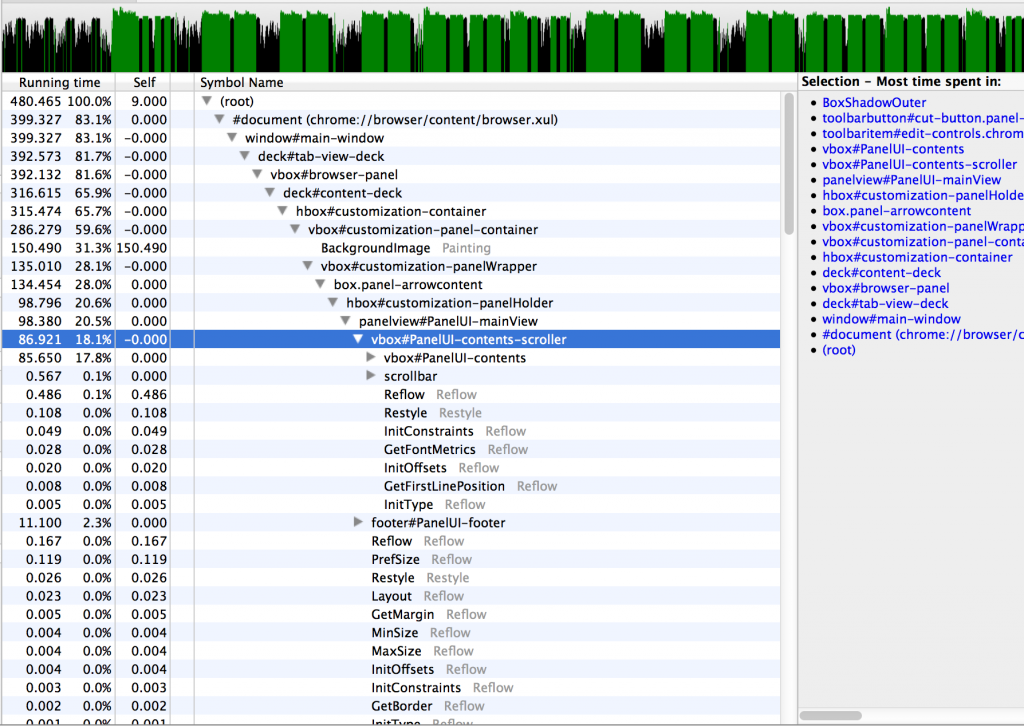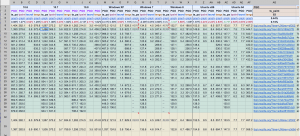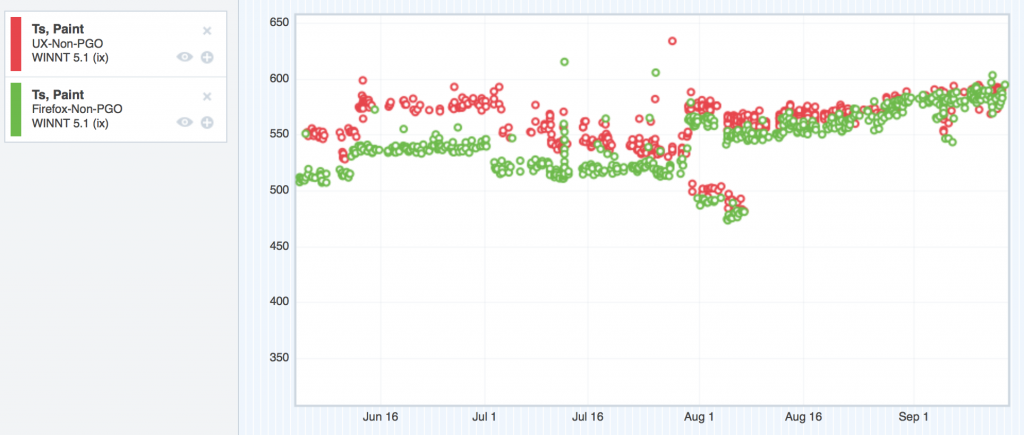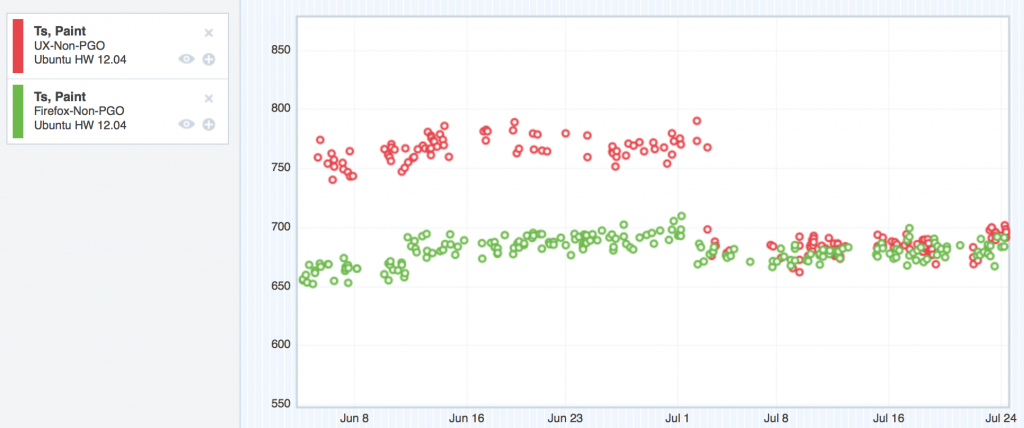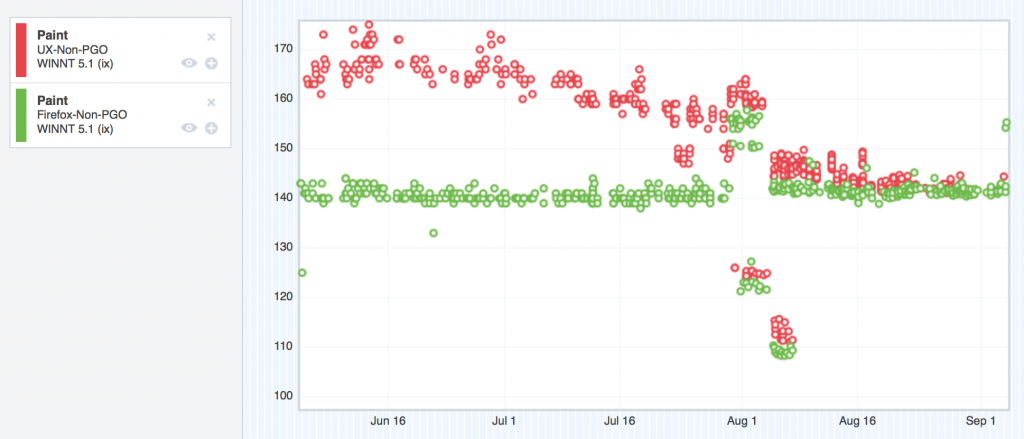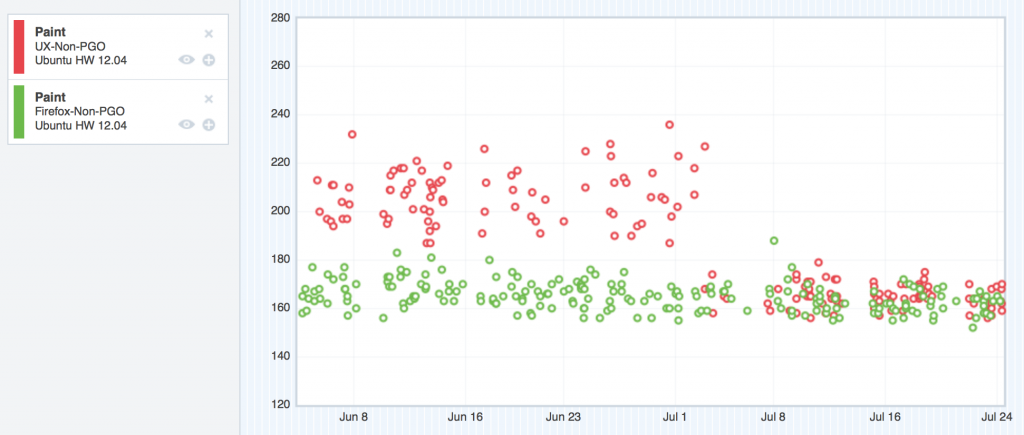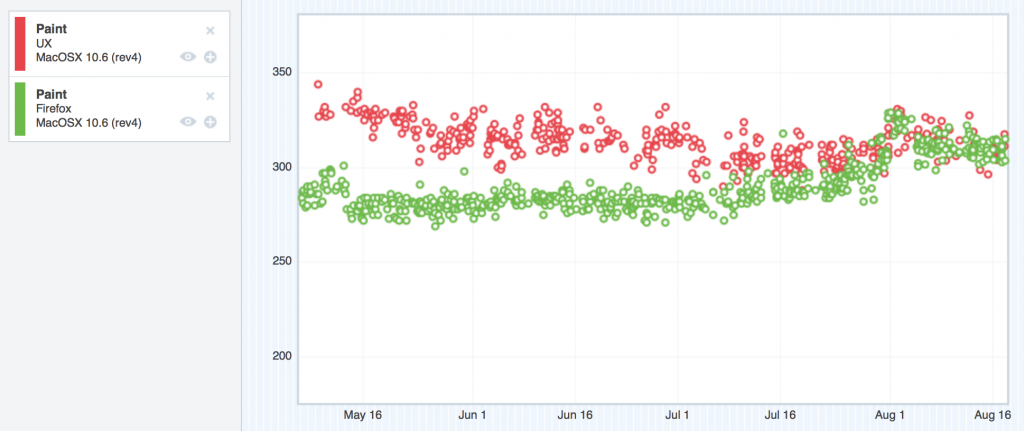Hey. I’ve started hacking on Electrolysis bugs. I’m normally a front-end engineer working on Firefox desktop, but I’ve been temporarily loaned out to help get Electrolysis ready to be enabled by default on Nightly.
I’m working on bug 989501. Basically, when you click on a link that targets “_blank” or uses window.open, we open a new tab instead. That’s no good – assuming the user’s profile is set to allow it, we should open the link in a new window.
In order to fix this, I need a clearer picture on what happens in the Firefox platform when we click on one of these links.
This isn’t really a tutorial – I’m not going to go out of my way to explain much here. Think of this more as a public posting of my notes during my exploration.
So, here goes.
(Note that the code in this post was current as of revision 400a31da59a9 of mozilla-central, so if you’re reading this in the future, it’s possible that some stuff has greatly changed).
I know for a fact that once the link is clicked, we eventually call mozilla::dom::TabChild::ProvideWindow. I know this because of conversations I’ve had with smaug, billm and jdm in and out of Bugzilla, IRC, and meatspace.
Because I know this, I can hook up gdb to see how I get to that call. I have some notes here on how to hook up gdb to the content process of an e10s window.
Once that’s hooked up, I set a breakpoint on mozilla::dom::TabChild::ProvideWindow, and click on a link somewhere with target=”_blank”.
I hit my breakpoint, and I get a backtrace. Ready for it? Here we go:
#0 mozilla::dom::TabChild::ProvideWindow (this=0x109afb400, aParent=0x10b098820, aChromeFlags=4094, aCalledFromJS=false, aPositionSpecified=false, aSizeSpecified=false, aURI=0xffe, aName=@0x0, aFeatures=@0x0, aWindowIsNew=0x10b098820, aReturn=0x7fff5fbfb648) at TabChild.cpp:1201 #1 0x00000001018682e4 in nsWindowWatcher::OpenWindowInternal (this=0x10b05b540, aParent=0x10b098820, aUrl=<value temporarily unavailable, due to optimizations>, aName=<value temporarily unavailable, due to optimizations>, aFeatures=<value temporarily unavailable, due to optimizations>, aCalledFromJS=false, aDialog=<value temporarily unavailable, due to optimizations>, aNavigate=<value temporarily unavailable, due to optimizations>, _retval=<value temporarily unavailable, due to optimizations>) at nsWindowWatcher.cpp:601 #2 0x0000000101869544 in non-virtual thunk to nsWindowWatcher::OpenWindow2(nsIDOMWindow*, char const*, char const*, char const*, bool, bool, bool, nsISupports*, nsIDOMWindow**) () at nsWindowWatcher.cpp:417 #3 0x0000000100e5dc63 in nsGlobalWindow::OpenInternal (this=0x10b098800, aUrl=@0x7fff5fbfbf90, aName=@0x7fff5fbfc038, aOptions=@0x103d77320, aDialog=false, aContentModal=false, aCalleePrincipal=<value temporarily unavailable, due to optimizations>, aJSCallerContext=<value temporarily unavailable, due to optimizations>, aReturn=<value temporarily unavailable, due to optimizations>) at /Users/mikeconley/Projects/mozilla-central/dom/base/nsGlobalWindow.cpp:11498 #4 0x0000000100e5e3a4 in non-virtual thunk to nsGlobalWindow::OpenNoNavigate(nsAString_internal const&, nsAString_internal const&, nsAString_internal const&, nsIDOMWindow**) () at /Users/mikeconley/Projects/mozilla-central/dom/base/nsGlobalWindow.cpp:7463 #5 0x000000010184d99d in nsDocShell::InternalLoad (this=<value temporarily unavailable, due to optimizations>, aURI=0x113eed200, aReferrer=0x1134c0fe0, aOwner=0x114a69070, aFlags=0, aWindowTarget=0x10b098820, aLoadType=<value temporarily unavailable, due to optimizations>, aSHEntry=<value temporarily unavailable, due to optimizations>, aSourceDocShell=<value temporarily unavailable, due to optimizations>, aDocShell=<value temporarily unavailable, due to optimizations>, aRequest=<value temporarily unavailable, due to optimizations>) at /Users/mikeconley/Projects/mozilla-central/docshell/base/nsDocShell.cpp:9079 #6 0x0000000101855758 in nsDocShell::OnLinkClickSync (this=0x10b075000, aContent=0x112865eb0, aURI=0x113eed3c0, aTargetSpec=<value temporarily unavailable, due to optimizations>, aFileName=@0x106f27f10, aPostDataStream=0x0, aDocShell=<value temporarily unavailable, due to optimizations>, aRequest=<value temporarily unavailable, due to optimizations>) at /Users/mikeconley/Projects/mozilla-central/docshell/base/nsDocShell.cpp:12699 #7 0x0000000101857f85 in mozilla::Maybe<mozilla::AutoCxPusher>::~Maybe () at /Users/mikeconley/Projects/mozilla-central/obj-x86_64-apple-darwin12.5.0/dist/include/nsCxPusher.h:12499 #8 0x0000000101857f85 in nsCxPusher::~nsCxPusher () at /Users/mikeconley/Projects/mozilla-central/docshell/base/nsDocShell.cpp:41 #9 0x0000000101857f85 in nsCxPusher::~nsCxPusher () at /Users/mikeconley/Projects/mozilla-central/obj-x86_64-apple-darwin12.5.0/dist/include/nsCxPusher.h:66 #10 0x0000000101857f85 in OnLinkClickEvent::Run (this=<value temporarily unavailable, due to optimizations>) at /Users/mikeconley/Projects/mozilla-central/docshell/base/nsDocShell.cpp:12502 #11 0x0000000100084f60 in nsThread::ProcessNextEvent (this=0x106f245e0, mayWait=false, result=0x7fff5fbfc947) at nsThread.cpp:715 #12 0x0000000100023241 in NS_ProcessPendingEvents (thread=<value temporarily unavailable, due to optimizations>, timeout=20) at nsThreadUtils.cpp:210 #13 0x0000000100d41c47 in nsBaseAppShell::NativeEventCallback (this=0x1096e8660) at nsBaseAppShell.cpp:98 #14 0x0000000100cfdba1 in nsAppShell::ProcessGeckoEvents (aInfo=0x1096e8660) at nsAppShell.mm:388 #15 0x00007fff86adeb31 in __CFRUNLOOP_IS_CALLING_OUT_TO_A_SOURCE0_PERFORM_FUNCTION__ () #16 0x00007fff86ade455 in __CFRunLoopDoSources0 () #17 0x00007fff86b017f5 in __CFRunLoopRun () #18 0x00007fff86b010e2 in CFRunLoopRunSpecific () #19 0x00007fff8ad65eb4 in RunCurrentEventLoopInMode () #20 0x00007fff8ad65c52 in ReceiveNextEventCommon () #21 0x00007fff8ad65ae3 in BlockUntilNextEventMatchingListInMode () #22 0x00007fff8cce1533 in _DPSNextEvent () #23 0x00007fff8cce0df2 in -[NSApplication nextEventMatchingMask:untilDate:inMode:dequeue:] () #24 0x0000000100cfd266 in -[GeckoNSApplication nextEventMatchingMask:untilDate:inMode:dequeue:] (self=0x106f801a0, _cmd=<value temporarily unavailable, due to optimizations>, mask=18446744073709551615, expiration=0x422d63c37f00000d, mode=0x7fff7205e1c0, flag=1 '\001') at nsAppShell.mm:165 #25 0x00007fff8ccd81a3 in -[NSApplication run] () #26 0x0000000100cfe32b in nsAppShell::Run (this=<value temporarily unavailable, due to optimizations>) at nsAppShell.mm:746 #27 0x000000010199b3dc in XRE_RunAppShell () at /Users/mikeconley/Projects/mozilla-central/toolkit/xre/nsEmbedFunctions.cpp:679 #28 0x00000001002a0dae in MessageLoop::AutoRunState::~AutoRunState () at message_loop.cc:229 #29 0x00000001002a0dae in MessageLoop::AutoRunState::~AutoRunState () at /Users/mikeconley/Projects/mozilla-central/ipc/chromium/src/base/message_loop.h:197 #30 0x00000001002a0dae in MessageLoop::Run (this=0x0) at message_loop.cc:503 #31 0x000000010199b0cd in XRE_InitChildProcess (aArgc=<value temporarily unavailable, due to optimizations>, aArgv=<value temporarily unavailable, due to optimizations>, aProcess=<value temporarily unavailable, due to optimizations>) at /Users/mikeconley/Projects/mozilla-central/toolkit/xre/nsEmbedFunctions.cpp:516 #32 0x0000000100000f1d in main (argc=<value temporarily unavailable, due to optimizations>, argv=0x7fff5fbff4d8) at /Users/mikeconley/Projects/mozilla-central/ipc/app/MozillaRuntimeMain.cpp:149
Oh my. Well, the good news is, we can chop off a good chunk of the lower half because that’s all message / event loop stuff. That’s going to be in every single backtrace ever, pretty much, so I can just ignore it. Here’s the more important stuff:
#0 mozilla::dom::TabChild::ProvideWindow (this=0x109afb400, aParent=0x10b098820, aChromeFlags=4094, aCalledFromJS=false, aPositionSpecified=false, aSizeSpecified=false, aURI=0xffe, aName=@0x0, aFeatures=@0x0, aWindowIsNew=0x10b098820, aReturn=0x7fff5fbfb648) at TabChild.cpp:1201 #1 0x00000001018682e4 in nsWindowWatcher::OpenWindowInternal (this=0x10b05b540, aParent=0x10b098820, aUrl=<value temporarily unavailable, due to optimizations>, aName=<value temporarily unavailable, due to optimizations>, aFeatures=<value temporarily unavailable, due to optimizations>, aCalledFromJS=false, aDialog=<value temporarily unavailable, due to optimizations>, aNavigate=<value temporarily unavailable, due to optimizations>, _retval=<value temporarily unavailable, due to optimizations>) at nsWindowWatcher.cpp:601 #2 0x0000000101869544 in non-virtual thunk to nsWindowWatcher::OpenWindow2(nsIDOMWindow*, char const*, char const*, char const*, bool, bool, bool, nsISupports*, nsIDOMWindow**) () at nsWindowWatcher.cpp:417 #3 0x0000000100e5dc63 in nsGlobalWindow::OpenInternal (this=0x10b098800, aUrl=@0x7fff5fbfbf90, aName=@0x7fff5fbfc038, aOptions=@0x103d77320, aDialog=false, aContentModal=false, aCalleePrincipal=<value temporarily unavailable, due to optimizations>, aJSCallerContext=<value temporarily unavailable, due to optimizations>, aReturn=<value temporarily unavailable, due to optimizations>) at /Users/mikeconley/Projects/mozilla-central/dom/base/nsGlobalWindow.cpp:11498 #4 0x0000000100e5e3a4 in non-virtual thunk to nsGlobalWindow::OpenNoNavigate(nsAString_internal const&, nsAString_internal const&, nsAString_internal const&, nsIDOMWindow**) () at /Users/mikeconley/Projects/mozilla-central/dom/base/nsGlobalWindow.cpp:7463 #5 0x000000010184d99d in nsDocShell::InternalLoad (this=<value temporarily unavailable, due to optimizations>, aURI=0x113eed200, aReferrer=0x1134c0fe0, aOwner=0x114a69070, aFlags=0, aWindowTarget=0x10b098820, aLoadType=<value temporarily unavailable, due to optimizations>, aSHEntry=<value temporarily unavailable, due to optimizations>, aSourceDocShell=<value temporarily unavailable, due to optimizations>, aDocShell=<value temporarily unavailable, due to optimizations>, aRequest=<value temporarily unavailable, due to optimizations>) at /Users/mikeconley/Projects/mozilla-central/docshell/base/nsDocShell.cpp:9079 #6 0x0000000101855758 in nsDocShell::OnLinkClickSync (this=0x10b075000, aContent=0x112865eb0, aURI=0x113eed3c0, aTargetSpec=<value temporarily unavailable, due to optimizations>, aFileName=@0x106f27f10, aPostDataStream=0x0, aDocShell=<value temporarily unavailable, due to optimizations>, aRequest=<value temporarily unavailable, due to optimizations>) at /Users/mikeconley/Projects/mozilla-central/docshell/base/nsDocShell.cpp:12699 #7 0x0000000101857f85 in mozilla::Maybe<mozilla::AutoCxPusher>::~Maybe () at /Users/mikeconley/Projects/mozilla-central/obj-x86_64-apple-darwin12.5.0/dist/include/nsCxPusher.h:12499 #8 0x0000000101857f85 in nsCxPusher::~nsCxPusher () at /Users/mikeconley/Projects/mozilla-central/docshell/base/nsDocShell.cpp:41 #9 0x0000000101857f85 in nsCxPusher::~nsCxPusher () at /Users/mikeconley/Projects/mozilla-central/obj-x86_64-apple-darwin12.5.0/dist/include/nsCxPusher.h:66 #10 0x0000000101857f85 in OnLinkClickEvent::Run (this=<value temporarily unavailable, due to optimizations>) at /Users/mikeconley/Projects/mozilla-central/docshell/base/nsDocShell.cpp:12502
That’s a bit more manageable.
So we start inside something called a docshell. I’ve heard that term bandied about a lot, and I can’t say I’ve ever been too sure what it means, or what a docshell does, or why I should care.
I found some documents that make things a little bit clearer.
Basically, my understanding is that a docshell is the thing that connects incoming stuff from some URI (this could be web content, or it might be a XUL document that’s loading the browser UI…), and connects it to the things that make stuff show up on your screen.
So, pretty important.
It seems to be a place where some utility methods and functions go as well, so it’s kind of this abstract thing that seems to have multiple purposes.
But the most important thing for the purposes of this post is this: every time you load a document, you have a docshell taking care of it. All of these docshells are structured in a tree which is rooted with a docshell owner. This will come into play later.
So one thing that a docshell does, is that it notices when a link was clicked inside of its content. That’s nsDocShell.cpp’d OnLinkClickEvent::Run, and that eventually makes its way over to nsDocShell::OnLinkClickSync.
After some initial checks and balances to ensure that this thing really is a link we want to travel to, we get sent off to nsDocShell::InternalLoad.
Inside there, there’s some more checking… there’s a policy check to make sure we’re allowed to open a link. Lots of security going on. Eventually I see this:
if (aWindowTarget && *aWindowTarget)
That’s good. aWindowTarget maps to the target=”_blank” attribute in the anchor. So we’ll be entering this block.
if (aWindowTarget && *aWindowTarget) {
// Locate the target DocShell.
nsCOMPtr<nsIDocShellTreeItem> targetItem;
rv = FindItemWithName(aWindowTarget, nullptr, this,
getter_AddRefs(targetItem));
So now we’re looking for the right docshell to load this new document in. That makes sense – if you have a link where target=”foo”, subsequent links from the same origin targeted at “foo” will open in the same window or tab or what have you. So we’re checking to see if we’ve opened something with the name inside aWindowTarget already.
So now we’re in nsDocShell::FindItemWithName, and I see this:
else if (name.LowerCaseEqualsLiteral("_blank"))
{
// Just return null. Caller must handle creating a new window with
// a blank name himself.
return NS_OK;
}
Ah hah, so target=”_blank”, as we already knew, is special-cased – and this is where it happens. There’s no existing docshell for _blank because we know we’re going to be opening a new window (or tab if the user has preffed it that way). So we don’t return a pre-existing docshell.
So we’re back in nsDocShell::InternalLoad.
rv = FindItemWithName(aWindowTarget, nullptr, this, getter_AddRefs(targetItem)); NS_ENSURE_SUCCESS(rv, rv); targetDocShell = do_QueryInterface(targetItem); // If the targetDocShell doesn't exist, then this is a new docShell // and we should consider this a TYPE_DOCUMENT load isNewDocShell = !targetDocShell;
Ok, so now targetItem is nullptr, targetDocShell is also nullptr, and so isNewDocShell is true.
There seems to be more policy checking going on in InternalLoad after this… but eventually, I see this:
if (aWindowTarget && *aWindowTarget) {
// We've already done our owner-inheriting. Mask out that bit, so we
// don't try inheriting an owner from the target window if we came up
// with a null owner above.
aFlags = aFlags & ~INTERNAL_LOAD_FLAGS_INHERIT_OWNER;
bool isNewWindow = false;
if (!targetDocShell) {
// If the docshell's document is sandboxed, only open a new window
// if the document's SANDBOXED_AUXILLARY_NAVIGATION flag is not set.
// (i.e. if allow-popups is specified)
NS_ENSURE_TRUE(mContentViewer, NS_ERROR_FAILURE);
nsIDocument* doc = mContentViewer->GetDocument();
uint32_t sandboxFlags = 0;
if (doc) {
sandboxFlags = doc->GetSandboxFlags();
if (sandboxFlags & SANDBOXED_AUXILIARY_NAVIGATION) {
return NS_ERROR_DOM_INVALID_ACCESS_ERR;
}
}
nsCOMPtr<nsPIDOMWindow> win =
do_GetInterface(GetAsSupports(this));
NS_ENSURE_TRUE(win, NS_ERROR_NOT_AVAILABLE);
nsDependentString name(aWindowTarget);
nsCOMPtr<nsIDOMWindow> newWin;
nsAutoCString spec;
if (aURI)
aURI->GetSpec(spec);
rv = win->OpenNoNavigate(NS_ConvertUTF8toUTF16(spec),
name, // window name
EmptyString(), // Features
getter_AddRefs(newWin));
So we check again to see if we’re targeted at something, and check if we’ve found a target docshell for it. We hadn’t, so we do some security checks, and then … what the hell is nsPIDOMWindow? I’m used to things being called nsIBlahBlah, but now nsPIBlahBlah… what does the P mean?
It took some asking around, but I eventually found out that the P is supposed to be for Private – as in, this is a private XPIDL interface, and non-core embedders should stay away from it.
Ok, and we also see do_GetInterface. This is not the same as QueryInterface, believe it or not. The difference is subtle, but basically it’s this: QueryInterface says “you implement X, but I think you also implement Y. If you do, please return a pointer to yourself that makes you seem like a Y.” GetInterface is different – GetInterface says “I know you know about something that implements Y. It might be you, or more likely, it’s something you’re holding a reference to. Can I get a reference to that please?”. And if successful, it returns it. Here’s more documentation about GetInterface.
It’s a subtle but important difference.
So this docshell knows about a window, and we’ve now got a handle on that window using the private interface nsPIDOMWindow. Neat.
So eventually, we call OpenNoNavigate on that nsPIDOMWindow. That method is pretty much like nsIDOMWindow::Open, except that OpenNoNavigate doesn’t send the window anywhere – it just returns it so that the caller can send it to a URI.
Through the magic of do_GetInterface, nsDocShell::GetInterface, EnsureScriptEnvironment, and NS_NewScriptGlobalObject, I know that the nsPIDOMWindow is being implemented by nsGlobalWindow, and that’s where I should go to to find the OpenNoNavigate implementation.
So off we go!
nsGlobalWindow::OpenNoNavigate just seems to forward the call, after some argument setting, to nsGlobalWindow::OpenInternal, like this:
return OpenInternal(aUrl, aName, aOptions, false, // aDialog false, // aContentModal true, // aCalledNoScript false, // aDoJSFixups false, // aNavigate nullptr, nullptr, // No args GetPrincipal(), // aCalleePrincipal nullptr, // aJSCallerContext _retval);
Having a glance around at the rest of the nsGlobalWindow::Open[foo] methods, it looks like they all call into OpenInternal. It’s the big-mamma opening method.
This method does a few things, including making sure that we’re not being abused by web content that’s trying to spam the user with popups.
Eventually, we get to this:
rv = pwwatch->OpenWindow2(this, url.get(), name_ptr, options_ptr, /* aCalledFromScript = */ false, aDialog, aNavigate, aExtraArgument, getter_AddRefs(domReturn));
and return the domReturn pointer back after a few more checks to our caller. Remember that the caller is going to take this new window, and navigate it to some URI.
Ok, so, pwwatch. What is that? Well, that appears to be a private interface to nsWindowWatcher, which gives us access to the OpenWindow2 method.
After prepping some arguments, much like nsGlobalWindow::OpenNoNavigate did, we forward the call over to nsWindowWatcher::OpenWindowInternal.
And now we’re almost done – we’re almost at the point where we’re actually going to open a window!
Some key things need to happen though. First, we do this:
nsCOMPtr<nsIDocShellTreeOwner> parentTreeOwner; // from the parent window, if any ... GetWindowTreeOwner(aParent, getter_AddRefs(parentTreeOwner));
So what that does is it tries to get the docshell owner of the docshell that’s attempting to open the window (and that’d be the docshell that we clicked the link in).
After a few more things, we check to see if there’s an existing window with that target name which we can re-use:
// try to find an extant window with the given name nsCOMPtr<nsIDOMWindow> foundWindow = SafeGetWindowByName(name, aParent); GetWindowTreeItem(foundWindow, getter_AddRefs(newDocShellItem));
And if so, we set it to newDocShellItem.
After some more security stuff, we check to see if newDocShellItem exists. Because name is nullptr (since we had target=”_blank”, and nsDocShell::FindItemWithName returned nullptr), newDocShellItem is null.
Because it doesn’t exist, we know we’re opening a brand new window!
More security things seem to happen, and then we get to the part that I’m starting to focus on:
nsCOMPtr<nsIWindowProvider> provider = do_GetInterface(parentTreeOwner);
if (provider) {
NS_ASSERTION(aParent, "We've _got_ to have a parent here!");
nsCOMPtr<nsIDOMWindow> newWindow;
rv = provider->ProvideWindow(aParent, chromeFlags, aCalledFromJS,
sizeSpec.PositionSpecified(),
sizeSpec.SizeSpecified(),
uriToLoad, name, features, &windowIsNew,
getter_AddRefs(newWindow));
We ask the parentTreeOwner to get us something that it knows about that implements nsIWindowProvider. In the Electrolysis / content process case, that’d be TabChild. In the normal, non-Electrolysis case, that’s nsContentTreeOwner.
The nsIWindowProvider is the thing that we’ll use to get a new window from! So we call ProvideWindow on it, to give us a pointer to new nsIDOMWindow window, assigned to newWindow.
Here’s TabChild::ProvideWindow:
NS_IMETHODIMP
TabChild::ProvideWindow(nsIDOMWindow* aParent, uint32_t aChromeFlags,
bool aCalledFromJS,
bool aPositionSpecified, bool aSizeSpecified,
nsIURI* aURI, const nsAString& aName,
const nsACString& aFeatures, bool* aWindowIsNew,
nsIDOMWindow** aReturn)
{
*aReturn = nullptr;
// If aParent is inside an <iframe mozbrowser> or <iframe mozapp> and this
// isn't a request to open a modal-type window, we're going to create a new
// <iframe mozbrowser/mozapp> and return its window here.
nsCOMPtr<nsIDocShell> docshell = do_GetInterface(aParent);
if (docshell && docshell->GetIsInBrowserOrApp() &&
!(aChromeFlags & (nsIWebBrowserChrome::CHROME_MODAL |
nsIWebBrowserChrome::CHROME_OPENAS_DIALOG |
nsIWebBrowserChrome::CHROME_OPENAS_CHROME))) {
// Note that BrowserFrameProvideWindow may return NS_ERROR_ABORT if the
// open window call was canceled. It's important that we pass this error
// code back to our caller.
return BrowserFrameProvideWindow(aParent, aURI, aName, aFeatures,
aWindowIsNew, aReturn);
}
// Otherwise, create a new top-level window.
PBrowserChild* newChild;
if (!CallCreateWindow(&newChild)) {
return NS_ERROR_NOT_AVAILABLE;
}
*aWindowIsNew = true;
nsCOMPtr<nsIDOMWindow> win =
do_GetInterface(static_cast<TabChild*>(newChild)->WebNavigation());
win.forget(aReturn);
return NS_OK;
}
The docshell->GetIsInBrowserOrApp() is basically asking “are we b2g?”, to which the answer is “no”, so we skip that block, and go right for CallCreateWindow.
CallCreateWindow is using the IPC library to communicate with TabParent in the UI process, which has a corresponding function called AnswerCreateWindow. Here it is:
bool
TabParent::AnswerCreateWindow(PBrowserParent** retval)
{
if (!mBrowserDOMWindow) {
return false;
}
// Only non-app, non-browser processes may call CreateWindow.
if (IsBrowserOrApp()) {
return false;
}
// Get a new rendering area from the browserDOMWin. We don't want
// to be starting any loads here, so get it with a null URI.
nsCOMPtr<nsIFrameLoaderOwner> frameLoaderOwner;
mBrowserDOMWindow->OpenURIInFrame(nullptr, nullptr,
nsIBrowserDOMWindow::OPEN_NEWTAB,
nsIBrowserDOMWindow::OPEN_NEW,
getter_AddRefs(frameLoaderOwner));
if (!frameLoaderOwner) {
return false;
}
nsRefPtr<nsFrameLoader> frameLoader = frameLoaderOwner->GetFrameLoader();
if (!frameLoader) {
return false;
}
*retval = frameLoader->GetRemoteBrowser();
return true;
}
So after some checks, we call mBrowserDOMWindow’s OpenURIInFrame, with (among other things), nsIBrowserDOMWindow::OPEN_NEWTAB. So that’s why we’ve got a new tab opening instead of a new window.
mBrowserDOMWindow is a reference to this thing implemented in browser.js:
function nsBrowserAccess() { }
nsBrowserAccess.prototype = {
QueryInterface: XPCOMUtils.generateQI([Ci.nsIBrowserDOMWindow, Ci.nsISupports]),
_openURIInNewTab: function(aURI, aOpener, aIsExternal) {
let win, needToFocusWin;
// try the current window. if we're in a popup, fall back on the most recent browser window
if (window.toolbar.visible)
win = window;
else {
let isPrivate = PrivateBrowsingUtils.isWindowPrivate(aOpener || window);
win = RecentWindow.getMostRecentBrowserWindow({private: isPrivate});
needToFocusWin = true;
}
if (!win) {
// we couldn't find a suitable window, a new one needs to be opened.
return null;
}
if (aIsExternal && (!aURI || aURI.spec == "about:blank")) {
win.BrowserOpenTab(); // this also focuses the location bar
win.focus();
return win.gBrowser.selectedBrowser;
}
let loadInBackground = gPrefService.getBoolPref("browser.tabs.loadDivertedInBackground");
let referrer = aOpener ? makeURI(aOpener.location.href) : null;
let tab = win.gBrowser.loadOneTab(aURI ? aURI.spec : "about:blank", {
referrerURI: referrer,
fromExternal: aIsExternal,
inBackground: loadInBackground});
let browser = win.gBrowser.getBrowserForTab(tab);
if (needToFocusWin || (!loadInBackground && aIsExternal))
win.focus();
return browser;
},
openURI: function (aURI, aOpener, aWhere, aContext) {
... (removed for brevity)
},
openURIInFrame: function browser_openURIInFrame(aURI, aOpener, aWhere, aContext) {
if (aWhere != Ci.nsIBrowserDOMWindow.OPEN_NEWTAB) {
dump("Error: openURIInFrame can only open in new tabs");
return null;
}
var isExternal = (aContext == Ci.nsIBrowserDOMWindow.OPEN_EXTERNAL);
let browser = this._openURIInNewTab(aURI, aOpener, isExternal);
if (browser)
return browser.QueryInterface(Ci.nsIFrameLoaderOwner);
return null;
},
isTabContentWindow: function (aWindow) {
return gBrowser.browsers.some(function (browser) browser.contentWindow == aWindow);
},
get contentWindow() {
return gBrowser.contentWindow;
}
}
So nsBrowserAccess’s openURIInFrame only supports opening things in new tabs, and then it just calls _openURIInNewTab on itself, which does the job of returning the tab’s remote browser after the tab is opened.
I might follow this up with a post about how nsContentTreeOwner opens a window in the non-Electrolysis case, and how we might abstract some of that out for re-use here. We’ll see.
And that’s about it. Hopefully this is useful to future spelunkers.
